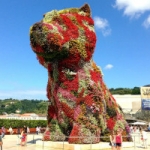 I returned this week from a trip to Rome and Venice, Italy. I had been to Rome in 1989, and Venice in 2000, but now had two of my three children with me. In 1989, my life was very different and I had no children. Then, cats roamed the streets of both cities more noticeably.
I returned this week from a trip to Rome and Venice, Italy. I had been to Rome in 1989, and Venice in 2000, but now had two of my three children with me. In 1989, my life was very different and I had no children. Then, cats roamed the streets of both cities more noticeably.
Last week, instead, dogs were everywhere. In the high end stores, on trains and buses, they are seen as pampered, well dressed and leashed. Siberian Huskies and Dachshunds seen shopping the aisles for Fendi and Chanel bags alongside their pet parents. Two dogs were snarling at each other, on and off, for 4 hours, on a train ride. No personnel seemed to care. There are even parking signs for your dog. It got me to wondering,… where were the cats?
It seems that there are now cat sanctuaries in Rome, where they have collected and deposited the majority of the cats that used to roam the streets. Venice, we would learn, has a special history with cats. While there we took a paper mache mask making class, which is a local artisan specialty. It included a history of the process, and it’s role in the city’s history, which soon became largely about cats. Venice developed the masks for physicians, which were stuffed with herbs, to protect them from exposure to the plague, brought into the city by seafaring merchants. Traders from the Middle East, some time later, brought cats with them, and they were effective rat hunters, ultimately helping end the plague in Venice. They have been revered ever since, explaining all the cat cards, metal or paper masks, and images all over the city.


Our teacher and host, Georgio, explained that he and his family were some of the 55,000 remaining Venetians. The city of Venice is not just sinking physically, but so is its population, which had been 120,000 just 30 years ago. The cats are disappearing along with the residents. One reason is that there was a Trap-neuter-return (TNR) program instituted in the 1960’s, that helped control the then overpopulation of cats perceived by some residents. But the development of cat litter in the 1960’s helped make it easier to keep cats indoors. The rise of tourism being the main business in Venice, along with the declining population, resulted in residents either renting their homes to tourists or selling them to be made into hotels. Both options do not involve keeping cats, and thus the noticeable decline. Sadly, the only reliable place to see cats are in the Aqua Alta bookstore, advertising their resident cats as a tourist attraction in a city that once teemed with them.

Dr. Dawn
Happy New Year
Please share and subscribe here





